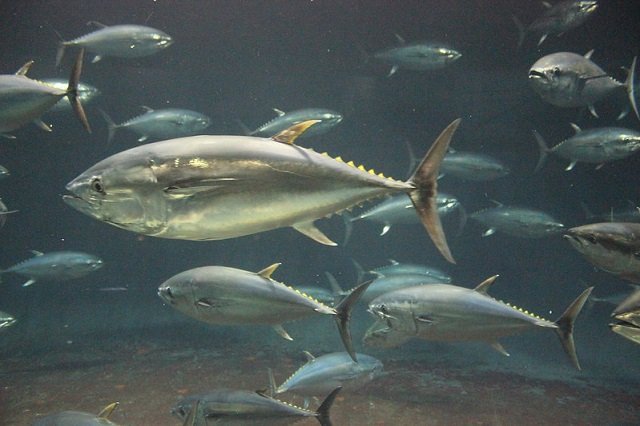Taking into consideration both food that humans consume and seafood processed for feed production, seafood consumption in EU member states equals 27 kg per head. The highest consumption at EU level is observed in Portugal (61.5 kg per head) while outside the EU, the top consumers are Korea (78.5 kg per head) followed by Norway (66.6 kg per head).
The global per head consumption is estimated at 22.3 kg.
Global demand for seafood is growing
Global seafood consumption has more than doubled in the past 50 years, to over 20 kg per capita per year in 2014.
As demand for seafood rises, the sustainability of fish stock becomes an ever more pressing issue.
Compared to other commodities, the share of globally produced seafood products that are traded internationally is very high and growing, mostly due to globalisation and the geographical discrepancy between aquaculture production happening mostly in Asia, and seafood demand mostly in Europe, North America and Asia.
Given that many nations rely on imports to meet national demands, assessments of the sustainability of seafood need to consider both domestic production and net imports, and whether imported seafood comes from sustainable sources.
Stay Always Informed
Join our communities to instantly receive the most important news, reports, and analysis from the aquaculture industry.
Why measure global seafood consumption footprint?
In a recent article “Global seafood consumption footprint”, JRC scientists use a new methodology to examine the impact of seafood supply chains across national boundaries – the global seafood consumption footprint.
This is the first ever measure of national footprints based on seafood consumption rather than production, broken down by sector to quantify the dependencies between capture fisheries and aquaculture through fishmeal production and trade by country.
The seafood consumption footprint provides policy-makers with evidence to encourage international collaboration and promote policies to ensure long-term sustainability of all seafood production.
What is our global seafood consumption footprint?
According to calculations using baseline data from 2011, global demand for seafood destined for human consumption is 143.8 million tonnes per year, and the overall consumption footprint, which also includes other uses of seafood, is 154 million tonnes.
China has by far the largest seafood consumption footprint (65 million tonnes), followed by the European Union (13 million tonnes), Japan (7.4 million tonnes), Indonesia (7.3 tonnes) and the United States (7.1 million tonnes).
In terms of consumption footprint per capita, the Republic of Korea scored highest (78.5 kg per capita), followed by Norway (66.6 kg), Portugal (61.5 kg), Myanmar (59.9 kg), Malaysia (58.6 kg) and Japan (58 kg) – China comes in seventh at 48.3 kg per capita.
How to measure global seafood consumption footprint
JRC scientists developed a model (Multi-Region Input-Output, MRIO) for the world seafood supply chain to investigate the impact of seafood consumption across national boundaries.
The model explores the interactions between capture fisheries and aquaculture, fishmeal and trade at the global level, and accounts for trade flows and interdependencies between different countries along the international supply chain, linking the extraction of raw materials, inter-industry flow, trade and final consumption.
Results from the model can provide policy-makers and consumers with information on the extent of reliance on producer nations for their seafood supplies.
They can support the assessment on whether seafood sources are exploited in accordance with the applicable or desired sustainability standards and objectives.
This information can help encourage international collaboration and promote policies to ensure long-term sustainability of all seafood production.
EU policies to preserve fish stocks
The Common Fisheries Policy (CFP) is a set of rules for managing European fishing fleets and for conserving fish stocks.
Stocks may be renewable, but they are finite. Some of these fishing stocks, however, are being overfished.
As a result, EU countries have taken action to ensure the European fishing industry is sustainable and does not threaten the fish population size and productivity over the long term.
As a major fishing power, and the largest single market for fisheries products in the world, the EU also plays an important role in promoting better governance through a number of international organisations.
This involves developing and implementing policy on fisheries management and – more generally – the Law of the Sea.
The EU works closely with its partners from around the globe through the United Nations system, including the Food and Agriculture Organisation (FAO), as well as in other bodies, such as the Organisation for Economic Co-operation and Development (OECD).
Reference (open):
Jordi Guillen, Fabrizio Natale, Natacha Carvalho, John Casey, Johann Hofherr, Jean-Noël Druon, Gianluca Fiore, Maurizio Gibin, Antonella Zanzi, Jann Th. Martinsohn. Ambio (2018). https://doi.org/10.1007/s13280-018-1060-9 https://link.springer.com/article/10.1007%2Fs13280-018-1060-9
Source: Cordis
Editor at the digital magazine AquaHoy. He holds a degree in Aquaculture Biology from the National University of Santa (UNS) and a Master’s degree in Science and Innovation Management from the Polytechnic University of Valencia, with postgraduate diplomas in Business Innovation and Innovation Management. He possesses extensive experience in the aquaculture and fisheries sector, having led the Fisheries Innovation Unit of the National Program for Innovation in Fisheries and Aquaculture (PNIPA). He has served as a senior consultant in technology watch, an innovation project formulator and advisor, and a lecturer at UNS. He is a member of the Peruvian College of Biologists and was recognized by the World Aquaculture Society (WAS) in 2016 for his contribution to aquaculture.




